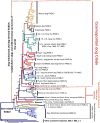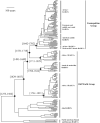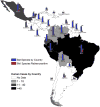The history of rabies in the Western Hemisphere
- PMID: 28365457
- PMCID: PMC5620125
- DOI: 10.1016/j.antiviral.2017.03.013
The history of rabies in the Western Hemisphere
Abstract
Before the introduction of control programs in the 20th century, rabies in domestic dogs occurred throughout the Western Hemisphere. However, historical records and phylogenetic analysis of multiple virus isolates indicate that, before the arrival of the first European colonizers, rabies virus was likely present only in bats and skunks. Canine rabies was either rare or absent among domestic dogs of Native Americans, and first arrived when many new dog breeds were imported during the period of European colonization. The introduction of the cosmopolitan dog rabies lyssavirus variant and the marked expansion of the dog population provided ideal conditions for the flourishing of enzootic canine rabies. The shift of dog-maintained viruses into gray foxes, coyotes, skunks and other wild mesocarnivores throughout the Americas and to mongooses in the Caribbean has augmented the risk of human rabies exposures and has complicated control efforts. At the same time, the continued presence of bat rabies poses novel challenges in the absolute elimination of canine and human rabies. This article compiles existing historical and phylogenetic evidence of the origins and subsequent dynamics of rabies in the Western Hemisphere, from the era preceding the arrival of the first European colonizers through the present day. A companion article reviews the current status of canine rabies control throughout the Western Hemisphere and steps that will be required to achieve and maintain its complete elimination (Velasco-Villa et al., 2017).
Published by Elsevier B.V.
Figures



References
-
- Aréchiga Ceballos N, Velasco-Villa A, Shi M, Flores-Chávez S, Barrón B, Cuevas-Domínguez E, González-Origel A, Aguilar-Setién A. New rabies virus variant found during an epizootic in white-nosed coatis from the Yucatan Peninsula. Epidemiol Infect. 2010;138:1586–1589. http://dx.doi.org/10.1017/S0950268810000762. - DOI - PMC - PubMed
-
- Baer GM, Smith JS. Vampire bat and bovine paralytic rabies. In: Baer GM, editor. The Natural History of Rabies. second. CRC Press, Inc; Boca Raton, Fla: 1991. pp. 390–400.
-
- Badrane H, Tordo N. Host switching in Lyssavirus history from the Chiroptera to the Carnivora orders. J Virol. 2001;75:8096–8104. http://dx.doi.org/10.1128/JVI.75.17.8096-8104.2001. - DOI - PMC - PubMed
-
- Banyard AC, Evans JS, Luo TR, Fooks AR. Lyssaviruses and bats: emergence and zoonotic threat. Viruses. 2014;6:2974–2990. http://dx.doi.org/10.3390/v6082974. - DOI - PMC - PubMed
-
- Basavaraju SV, Kuehnert MJ, Zaki SR, Sejvar JJ. Encephalitis caused by pathogens transmitted through organ transplants, United States, 2002-2013. Emerg Infect Dis. 2014;20:1443–1451. http://dx.doi.org/10.3201/eid2009.131332. - DOI - PMC - PubMed
Publication types
MeSH terms
Grants and funding
LinkOut - more resources
Full Text Sources
Other Literature Sources
Medical

